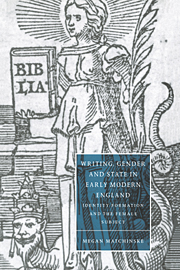Book contents
- Frontmatter
- Contents
- Acknowledgments
- Introduction
- 1 Resistance, Reformation, and the remaining narratives
- 2 Framing recusant identity in Counter-Reformation England
- 3 Legislating morality in the marriage market
- 4 Gender formation in English apocalyptic writing
- 5 Connections, qualifications, and agendas
- Notes
- Bibliography
- Index
- Cambridge Studies in Renaissance Literature and Culture
2 - Framing recusant identity in Counter-Reformation England
Published online by Cambridge University Press: 23 October 2009
- Frontmatter
- Contents
- Acknowledgments
- Introduction
- 1 Resistance, Reformation, and the remaining narratives
- 2 Framing recusant identity in Counter-Reformation England
- 3 Legislating morality in the marriage market
- 4 Gender formation in English apocalyptic writing
- 5 Connections, qualifications, and agendas
- Notes
- Bibliography
- Index
- Cambridge Studies in Renaissance Literature and Culture
Summary
The daughter of a Thomas Myddleton, wax chandler, Margaret Clitherow married a butcher in her thirteenth year, converted to Catholicism sometime after that marriage, and bore at least three children who survived. According to her only modern biographer, she was an “ideal Elizabethan wife” and an exemplary Catholic, a woman who spent the bulk of her time caring for family and house and trying to rekindle the faith in her community. Clitherow ran into trouble, however — religious trouble — when local authorities began to monitor attendance at church and levy fines against those who failed to appear. Clitherow was finally tried for priest-harboring, a treasonous crime punishable in the 1580s by death. During the course of her trial, Clitherow literally refused to plead; she refused to answer the charges against her, responding to her inquisitors instead with silence. Clitherow was executed because of that refusal; her sentence fell in accord with her voicelessness. Accordingly, in 1586, Clitherow was pressed to death. She died leaving no record of her life, no personal account of her ordeals — nothing, not even a letter. Instead her narrative was written after the fact, by one of her confessors, Father John Mush.
Clitherow's narrative is included in this study precisely because of its compromised lineage.
- Type
- Chapter
- Information
- Writing, Gender and State in Early Modern EnglandIdentity Formation and the Female Subject, pp. 53 - 85Publisher: Cambridge University PressPrint publication year: 1998



